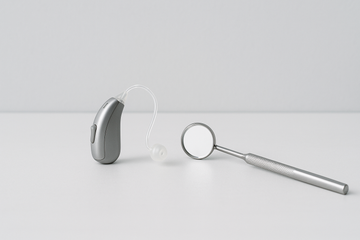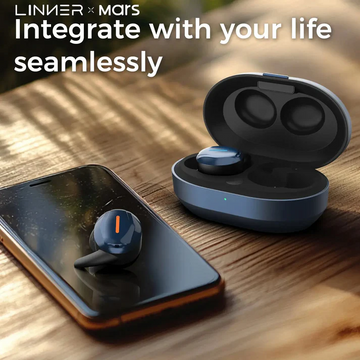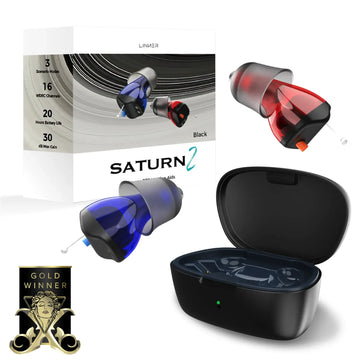Bluetooth hearing aids have revolutionized the hearing care sector as they allow users to wirelessly connect to smartphones, TVs, laptops, and so on. The feature enables direct audio streaming and more control over the volume and settings using mobile applications. However, how much good can be said in despite the numerous advantages, it is important to pose the question: What are the drawbacks of Bluetooth hearing aids?
This article will look closely at the general disadvantages of Bluetooth hearing aids, make you aware of how to optically select the best devices according to your hearing needs, and provide you with alternatives, such as Sound Linner Mercury and Linner Saturn OTC hearing aids.
Introduction to Bluetooth Hearing Aids
Bluetooth hearing aids are wireless and connect with devices that are compatible with this technology, so that users can direct the audio to their hearing aid. As an example, you may receive a call on the phone without an external speaker and listen to music or television without headphones. Life becomes easier, and understanding of speech and entertainment may be enhanced through this integration.
Nevertheless, similar to most superior technologies, Bluetooth hearing aids are not flawless. Although the concept of connecting wireless sounds attractive, most users face technological and usability challenges, which negatively affect them. This is why it is necessary to learn about the disadvantages of a Bluetooth hearing aid before buying it.
Disadvantages of Bluetooth Hearing Aids
Now, let us examine the most widespread disadvantages connected with Bluetooth hearing aids.
1. Limited Battery Life
Perhaps the most significant downside of Bluetooth hearing aids is battery consumption.
Streaming audio—such as music or phone calls—through Bluetooth can dramatically reduce battery life, often limiting usage to 6–8 hours per charge.
For users who rely on hearing aids throughout the day, this short battery span falls far short of their needs.
Even with rechargeable options, constant recharging becomes a daily inconvenience, especially if one forgets or lacks access to a charger during the day.
This limitation can impact both functionality and peace of mind, particularly for users who are out and about for extended periods.
2. Unstable Connection
The intermittent or unstable connection of the Bluetooth hearing aids has been reported as one of the most common complaints.
Bluetooth technology is based on short-range signals. When you go too distant from your phone or device (usually greater than 10 meters), the signal may drop or go off.
It has a probability of disconnection or delays, even when connected, especially in busy conditions where there are other wireless devices around the area of concern.
There is also a lack of audio sync when viewing videos, which complicates lip reading and communication.
To individuals who require hearing assistance that is stable and dependable, these interferences may be infuriating and even troublesome at the same time.
3. Complicated Operation
Numerous Bluetooth hearing aids cannot be used fully without pairing them to a smartphone or downloading an accessory application.
This can be cited as easy to configure by young or technologically proficient users, but difficult for older adults in terms of setting up, updates, and navigation.
Even simple operations such as volume control or switching channels will have to breeze through several app screens, which is not always inherent.
The Bluetooth hearing aids also have to be re-paired sometimes, and this may be confusing to users who do not have knowledge of the same.
To a prospective user who needed a plug-and-play experience, Bluetooth hearing aids might seem more complex than is necessary.
4. Software-Dependent and Prone to Glitches
Bluetooth hearing aids are strictly software-based, which brings with it a plethora of potential problems:
Devices can go out of service or lose major features, either due to an update in the app or firmware.
Certain updates cannot be backward-compatible, causing problems if you are using an older phone.
Technical troubleshooting involves fixing or correcting apps that crash, going into unresponsive mode, or disconnection.
This makes software dependency introduce unpredictability, which some users would, on their part, get overwhelmed or even irritated by , especiallyolder persons in particular.
5. Compatibility Issues
Bluetooth is not a universal standard; there exist different versions (e.g., Bluetooth 4.2 vs. 5.0), and using one and another by different manufacturers and devices can cause certain problems (see e.g.), including:
Failure to connect with some smartphones, tablets, or TVs from the past.
Restricted streaming or blocking of non-Android or non-Apple devices.
There are those Bluetooth hearing aids, which allow mono streaming on a particular platform.
It is important that users ensure their devices are compatible with Bluetooth hearing aids before buying one. Many people fail to realize this fact after making their purchases.
6. Potential Privacy Risks
Bluetooth technology casts a shadow with an additional threat to privacy and data security, especially in situations when hearing aids are paired with smartphones or applications that use the cloud.
Bluetooth signals, which are not encrypted, are liable to interception.
The smartphone apps that can control hearing aids can gather personal information, such as the hearing profiles, whereabouts, and usage habits.
Once a device gets hacked or hacked into, it might record or broadcast audio without the user's permission.
Data protection is not provided correctly in cheap hearing aids or older ones, although most of the contemporary models are quite secure, which concerns privacy-sensitive users.

How to Choose a Hearing Aid
When you have doubts about using Bluetooth all over again or simply need to locate a more comfortable solution, it is very important to realize how to select the best hearing aid that suits you.
Know Your Hearing Loss Level
The first one is to determine the degree of your hearing loss:
Mild: Ringing inside your head when you're grateful, quiet, and everything is peaceful
Moderate: Need help to understand someone to the extent of recognizing keywords.
Severe/Profound: Still needs special hearing devices with great amplification.
Online tests can give you a basic idea, but to ascertain the hearing levels well, a visit to the audiologist is preferred.
Select a Hearing Aid Style
Hearing aids are of four common types, and each has its benefits:
1. BTE (Behind-the-Ear)
It is fixed behind the ear, connected with a tube that extends into the ear canal
It is appropriate for any amount of hearing loss
Less expensive to handle and take care of, but more noticeable
2. RIC (Receiver-in-Canal)
Same as BTE except that the receiver is fitted into the ear canal
Sound is much clearer and is hidden by the style
It is applicable to mild to profound deafness
3. ITE (In-the-Ear)
Fit exactly in the outer ear and are custom-made to match this area completely
It is easier to insert and remove
The models are okay with moderate and mild hearing loss.
4. CIC (Completely-in-Canal)
CIC hearing aids are hardly noticeable and is placed right into the ear canal
Ideal among the aesthetically sensitive users who are mild or moderately impaired
Short battery life and less functionality because of the size
Decide Which Features You Need
Advanced features are not mandatory for all users. Consider:
Will you prefer rechargeable batteries or those that can be replaced? How long is the battery life?
Does your device need to be linked via Bluetooth and streaming, or can it be as simple as manual control?
Would you like feedback, rejection, or noise adaptation?
Having a clear understanding of what you need will simplify selecting the most suitable one without paying extra money for functions you will hardly use.
Set Your Budget
OTC hearing aids can be bought for generally 100-500 dollars, whereas on-prescription devices can exceed 3,000 dollars per ear. Fill in your budget against the hearing.
To get simple amplification and ease of operation, consider cheaper OTC models.
To have personal sound tuning, app compatibility, and long-term application, invest in costly alternatives.
Hearing Aid Recommendations
In case you think Bluetooth hearing aids are too complicated or unreliable, there are also great alternatives that would provide a high quality of sound with the same level of reliability.
1. Linner Mercury OTC Hearing Aid
The Linner Mercury is among the most sophisticated Over-the-Counter (OTC) hearing aids in the modern-day market. It is made to adapt to people with mild to moderate hearing impairment and is incorporated with smart technology and easy operation. Striking characteristics are:
Rechargeable Battery: A full one allows 30 hours of operation, and the portable charging case brings several charges to use a long way away.
Active Noise Cancellation (ANC): Linner Mercury employs AI-assistance sound processing, and the technology helps to eliminate background noise, which will enable more successful conversations in loud spaces.
Comfort Designed: This device has a compact, discreet design and ergonomic design that sits comfortably behind the ear for long-term wear.
Self-Fitting Application: The customization of the settings and application of their hearing tests can be done by the user without visiting the clinic.
Altogether, Linner Mercury offers all the benefits of a tech-savvy, customizable device at a reasonable price and is therefore perfect for any user looking to spend less money on more capabilities and customization.
2. Linner Saturn Series OTC Hearing Aids
The Linner Saturn Series is a strong and high-end product suitable for users with a moderate and severe degree of hearing loss. These are hearing aids that are clinically graded with user-intuitive controls and are made to meet the needs of people who need more dynamic sound amplification.
Ultra-High Sound Clarity: The Saturn Series has dual microphones and is equipped with its sound clarity amplifier with maximum feedback suppression, creating the most life-like sound and less noise.
Long Battery Life: It has 40 hours of battery life, and it takes a short time to charge.
Improved Speech Recognition: They are configured to set voices and background noise apart, and so, conversations even in crowded areas are a lot simpler.
CIC form factor (Completely-in-Canal): The almost invisible and the perfect fit CIC design will provide you with the aesthetic and the acoustical advantage.
Smart App Controls: Dial up how you want to hear on your phone, whether in the house, outside, or in a restaurant.
When you need a high-quality over-the-counter hearing device that can perform with near-professional-grade effect, you have to consider the Linner Saturn Series because of its quality performance, discretion, and capability to empower the user.
They are both meant to be used with mild to moderate hearing loss, and they are ideal products for people who like their simplicity, reliability, and performance, who do not require Bluetooth connection.

FAQ
Why do Bluetooth hearing aids break frequently?
Sudden dropouts may occur because of the distance, interference, or the firmware being out of date.
Do Bluetooth hearing aids have difficulty in use?
They usually are complex to set up and pair, and others need software updates, which can be rigorous for people who are not conversant with technology.
Are Bluetooth hearing aids compatible with a phone?
Not always. Some models are compatible only with iOS or the latest Androids. Never forget to check compatibility.
Do Bluetooth-free hearing aids suit seniors better?
There are non-Bluetooth types such as Linner Mercury, which can be more suited to the user who has a priority in usability and reliability.
Are Bluetooth hearing aids posing a threat to privacy?
Potentially, yes. Weak connections or data mining applications might leak user data or audio.
Conclusion
What are the downsides of Bluetooth hearing aids? These may be convenient and interconnected, but they also have a number of disadvantages, such as short battery life, unstable connections, complex use, software errors, compatibility problems, and privacy problems. These drawbacks weigh down much more than the usefulness to most users.
Fortunately, there are other modern options such as the Linner Mercury and Linner Saturn, which offer superior performance without the need to use Bluetooth. If you call yourself a tech-savvy person or just seek a simple and confident way of hearing, these OTC hearing aids make a fuss-free step towards sound hearing.
Read more
Are Costco Hearing Aids as Good as Others?







![Linner Mercury Clarity OTC Hearing Aids [FSA & HSA Eligible] Linner](http://www.linnerlife.com/cdn/shop/files/Linner-Mercury-Clarity-OTC-Hearing-Aids-_FSA-_-HSA-Eligible_-Linner-110038953.webp?v=1725853434&width=360)

![Linner Mars OTC Hearing Aids [FSA & HSA Eligible] Linner](http://www.linnerlife.com/cdn/shop/files/Linner-Mars-OTC-Hearing-Aids-_FSA-_-HSA-Eligible_-Linner-110039213.webp?v=1725865495&width=360)
